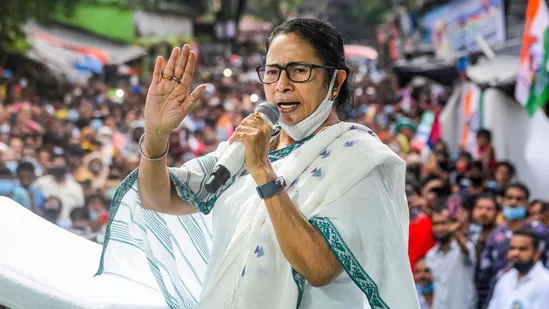Mamata Banerjee’s flight to go national has stalled before take off.
The Trinamool Congress leader, flush with an impressive electoral victory over the Bharatiya Janata Party (BJP) in West Bengal, saw herself as the only politician equipped to take on Narendra Modi in the 2024 elections. She set out to win friends and influence people in states as far-flung as Goa – where she had no presence till very recently – and Tripura. In the latter, she did not get a single seat in the Tripura civic elections, where the BJP won all but five of the 222 seats.
In the forthcoming elections in Goa, her party is trying to mop up Congress and other leaders, but it’s not working. Locals are bemused at a Bengali politician in their midst, who had not even a token presence earlier. The TMC seems to have the right funds and has plastered the state with her posters, but most analysts are convinced that the party will not open its account.
Banerjee visited to Mumbai to meet the Shiv Sena and Sharad Pawar, now perhaps the senior-most politician in India. With Uddhav Thackeray hospitalised, she met his son Aditya (she had once said she would never meet Rahul Gandhi) but soon after, the party issued a statement that there could not be any multi-party alliance that did not include the Congress. The Thackerays then promptly went and met Sonia Gandhi and sealed it formally.
Pawar made ambitious noises that he has cultivated into high art, which could be interpreted in many ways. But no commitment to Banerjee was forthcoming.
Clearly, no one is buying Banerjee’s plan of ‘Anyone But Congress’, not only because it is too early to finalise any front, but also because the Congress has a national presence, the only opposition party to do so. Most others remain confined to their home states and cannot make a dent anywhere else. Mamata’s overreach is very premature and she has forgotten that in India, naked ambition is never a good idea. Narendra Modi could get away with it and could walk all over in-party opposition, knowing he was backed by powerful figures, but she – and others – do not have that luxury. At the moment she continues to be a provincial politician, a queen in her own domain where her writ runs, but just one among equals, such as M.K. Stalin of Tamil Nadu. She may dislike Congress, but others don’t share her antipathy.
It is difficult to ignore the fact that the Congress, which got only 44 parliamentary seats, got a 19% of the national vote, which is much more than any other party besides the BJP. Rahul Gandhi, for all his weaknesses, is a name and face recognised all over India. The Congress will have to get real and cannot behave as if it is still the dominant party in India. Yet, as in the case of Maharashtra, there are signs that it is realising that.
Banerjee wants to finish off the Congress and take over that space, but this fantasy does not take into account the history and legacy of the 135-year-old national party. Others, however reluctant they may be, have recognised this and are ready to accommodate it, even if it means sacrificing a few seats, such as in Bihar when the Rashtriya Janata Dal gave many more seats to the Congress than warranted.
This realisation is most visible in the decision of the Shiv Sena to join the UPA. Through its existence going back to 1966, the two have been sworn enemies in Mumbai, whatever shadowy deals that may have taken place. The Congress talked of secularism; the Sena was openly nativist, going after ‘outsiders’. In the 1980s, the Sena pivoted and began drumming up anti-Muslim sentiments, which came to a peak in 1992-93 when the party went on a rampage against the minority community. Bal Thackeray made incendiary speeches, his paper Saamna wrote editorials in the same vein. Hundreds of Muslims died in what was almost a pogrom. Sena leaders were named but somehow stayed out of jail.
Signing up with the BJP was the next logical step and the two remained partners for 25 years. The Sena was uncomfortable with Modi from the very beginning and though it joined the government in the state with the BJP, continuously attacked the latter. The Sena pulled out from the partnership after 2019 and formed a three-way front with the Nationalist Congress Party and Congress.
The coalition has stayed the course under Uddhav Thackeray, who has turned out to be a sober figure, winning admirers even among Sena-skeptics.
With this history, for it to sign up with the Congress at the national level is nothing short of revolutionary. Strange things do happen in politics, and pragmatism is the keyword here. Banerjee, otherwise an astute politician, will have to make up her mind which way her future lies, sooner or later.













